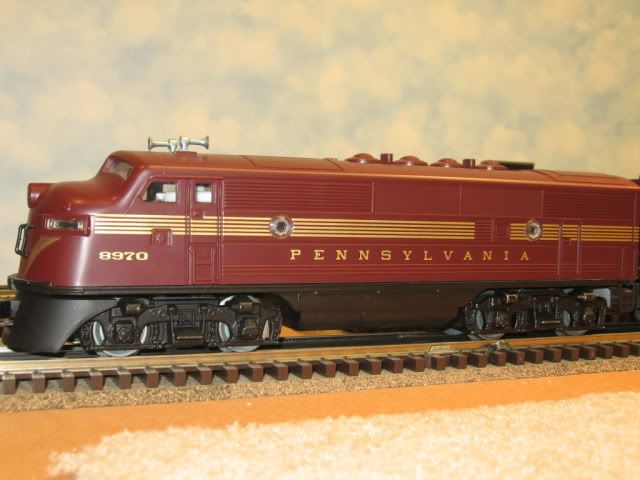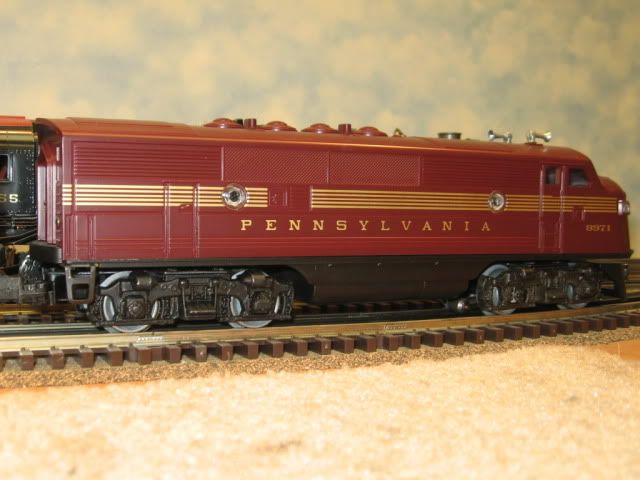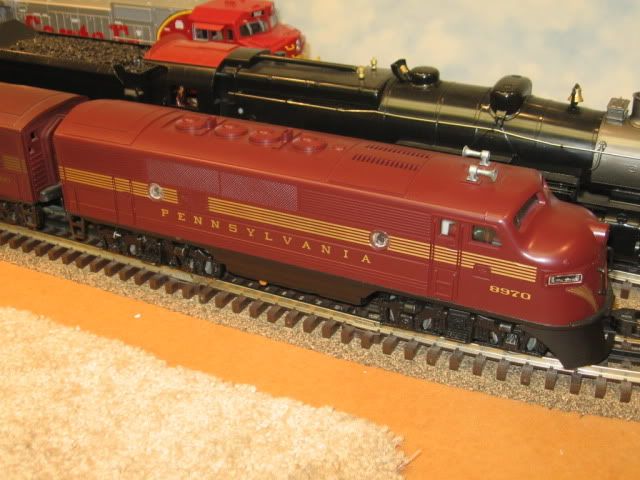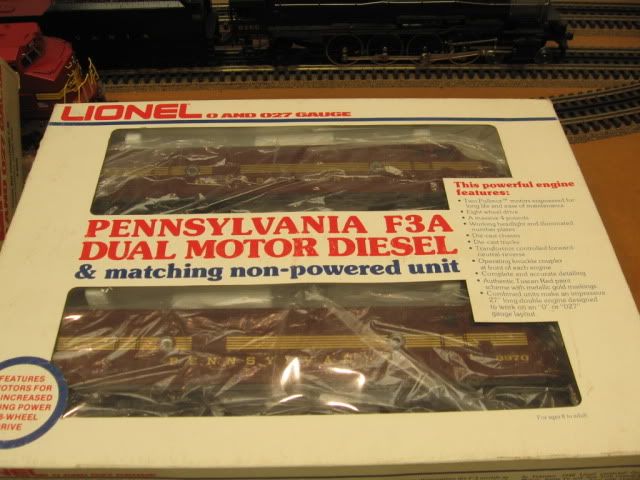Just curious as to why MPC removed most portholes and other details from the F3's beyond that needed to aid in printing the sides? The details are already in the tools...so the cost savings had to be minimal at most. If costing more to remove the items. I think I read they had slips that fit into the tooling to alter the details.
Replies sorted oldest to newest
I thought MPC had the same detail variations as Lionel. For example some MPC F3s had the level of detail of the later Lionel Corp F3s like the 2383 - no porthololes, add-on ladders, roof screens or grab irons -- whereas other MPC F3s had some of those features similar to Lionel Corp's 2343 or 2353 (although I am not sure if an MPC F3 ever roof screens instead of louvers).
MPC F3 shells do not have louvers on their nose (more or less under the number boards). There are probably other differences as well.








Early MPC used a lot of PW dies so their early F3s were made from them. As the pics above show over time MPC added more features and working horns.
It appears that the early MPC F3's used the same dies that Lionel used back in 1955...
Marty
My MPC CP A-A set that I bought new back in the Seventies had filled-in portholes. I know because the first thing I did after buying them was to open up the holes and put PW porthole lenses in them.
Still have them, by the way.
I had the MPC first release of the Santa Fe F3 #8652 and it had closed portholes but it was a great runner and at the time, owning a brand new Santa Fe F3 ABA set was to me a miracle.
Like David mentioned above, MPC got me back into Lionel trains again and carried the hobby through to where it is today. Not enough good can be said about this period in Lionel train history.
Steve, Lady and Tex
In 1979 Lionel MPC released upgraded versions of the F-3AAs in Pennsylvania livery with the Brunswick green 8952, powered, and 8953 dummy. The port holes, front grab irons and dual motors from the early 1950s PW days returned.
The upper part of the bodies still had louvers rather than screens and there was no Magne-Traction, but the new units were so much nicer than the older MPC units that I bought both the green and later tuscan versions. Lionel never did PRR F-3s in the PW era, which is one of the reasons I still own them.
Ed Boyle
I had the MPC first release of the Santa Fe F3 #8652 and it had closed portholes but it was a great runner and at the time, owning a brand new Santa Fe F3 ABA set was to me a miracle.
Like David mentioned above, MPC got me back into Lionel trains again and carried the hobby through to where it is today. Not enough good can be said about this period in Lionel train history.
Steve, Lady and Tex
Roger, that!!
My favorite MPC F3 was the Amtrak bloodynose pointless arrow. I'm looking for an MPC RioGrande dummy F3 to make into an ex Rio Grande Penn Central yellow repaint.
I am pretty sure the current PW F3 tooling is still original Lionel tooling from the PW era. They just refine and clean stuff up over time. Though I could be wrong...but at least they are new tools cast off the original master....but Im sure Lionel cast new working tools all the time in the 50's as well of a master.
The Lionel Corporation removed the port-holes in the PW era. They also removed the nose-grabs, two piece cab ladders, and the screened vents. These were all gone by the time General Mills got a hold of the dies.
Once General Mills began production, the first F-3's were essentially copies of the late Lionel Corp F-3's, lacking port holes, screened vents, nose grabs, two-piece cab ladders, plus the elimination of the nose vents.
Over time MPC removed the side vents as needed to allow for fancier decoration, along with the addition of the much-loathed ridges along the bottom edge of the die which helped in the printing og the stripes on the Santa Fe F-3.
By the late 70's the trend began a slow reversal, first bringing back the ports and nose grabs, then the two-piece ladders, then the screened vents, then the nose vents, then the side vents, and finally the elimination of the bottom ridges.
Jon ![]()
Slightly off-topic, but what was modern Lionel's first true Scale F3 model?
MPC changed the body style on each F3 it made up until the late 70s
The 1st one, made in 73 is pretty much like a late postwar 2383 only w/ no vents on the lower part of the nose.
The Milw & D&RGW units are missing a set of vents on the side - only 3 while the B&O & postwar units had 4,
The changes went on unit there was just 1 vent, towards the rear of the body & ribs were put in on the lower part of the body ( similar as the Alcos). The B units did not have the ribs, but at some point lost the 2 vents on the side of the body & went to one. Lionel restored pretty much all of the original detail w/ the PWC F3 series although the Texas Special reissue B Unit only has one side vent. The only thing that has not been part back, IIRC, is the door detail on the nose, which was taken off when postwar Lionel made the 2242 New Haven F3s in 58
Slightly off-topic, but what was modern Lionel's first true Scale F3 model?
Sam, I believe the first Lionel Scale F3 was released a few years ago. But that's enough on scale, this is a great MPC thread.
Steve, Lady and Tex
As a recap (of sorts), MPC's F-3's were similar to the late PW F-3's in that most of the original detailing found on the early PW F-3's was gone by the mid 1950's.
MPC production went the opposite of the PW era in that as time went on MPC restored more of the detailing, as opposed to the PW era, as fine detailing was gone as time went on.
The first MPC F-3's have the distinction of being manufactured at the Hillside factory, the first F-3 made in Mt. Clemmens was the Rio Grande.
Ken
As a recap (of sorts), MPC's F-3's were similar to the late PW F-3's in that most of the original detailing found on the early PW F-3's was gone by the mid 1950's.
MPC production went the opposite of the PW era in that as time went on MPC restored more of the detailing, as opposed to the PW era, as fine detailing was gone as time went on.
Correct; it could be seen as a pendulum effect where the trend completed its swing roughly mid-way in the MPC era and was swinging back towards the end.
Were the first MPC F3's made using the existing parts bin from Hillside? had any production occurred at Hillside since 1967ish?
Were the first MPC F3's made using the existing parts bin from Hillside? had any production occurred at Hillside since 1967ish?
Not 100% certain on the first question, but it seems likely. In answer to your second question, Lionel MPC did indeed maintain limited operations at the Hillside factory (and as a consequence occupied less square footage since the bulk of production moved to Mt. Clemens) up until 1974 when they closed the remainder of their toy train production there. Lenny Dean continued his tenure with Lionel at Hillside as well if I recall correctly.
Were the first MPC F3's made using the existing parts bin from Hillside? had any production occurred at Hillside since 1967ish?
Maybe. The tooling was changed for the B&O F3 eliminating the nose louvers.
Check out this book for a detailed history of Lionel's factories:
Ken
No. The Baltimore & Ohio, Canadian Pacific, Rio Grande and Amtrak F-3's were all made in Hillside. The first Michigan-made F-3's were the Preamble, Milwaukee Road and Southern.
Were the first MPC F3's made using the existing parts bin from Hillside? had any production occurred at Hillside since 1967ish?
They definitely weren't "parts bin" creations. Hillside train production continued through December 1974. All remaining tooling and work-in-process parts was transferred to Michigan by May 1975. Notable things to come out of Hillside in the early 1970's were the F-3's, 8206 steam locomotive and many accessories.
Were the first MPC F3's made using the existing parts bin from Hillside? had any production occurred at Hillside since 1967ish?
Not 100% certain on the first question, but it seems likely. In answer to your second question, Lionel MPC did indeed maintain limited operations at the Hillside factory (and as a consequence occupied less square footage since the bulk of production moved to Mt. Clemens) up until 1974 when they closed the remainder of their toy train production there. Lenny Dean continued his tenure with Lionel at Hillside as well if I recall correctly.
Lenny and the Service Department were based out of Hillside until the plant closing at the end of 1974. In 1975, the "Service Center East" opened in Little Falls, NJ, which is where Lenny operated from until the closure and consolidation to Michigan in May 1979.
Were the first MPC F3's made using the existing parts bin from Hillside? had any production occurred at Hillside since 1967ish?
Maybe. The tooling was changed for the B&O F3 eliminating the nose louvers.
Check out this book for a detailed history of Lionel's factories:
Bob does a great job of covering the various US factories over the years. I'd also recommend the TM Volume 4 1970-1980 book for interviews with key employees of the period. While the info isn't 100% accurate, it does a good job of telling the story of the late New Jersey and early Michigan years.
Hope this helps-
Todd
Just curious as to why MPC removed most portholes and other details from the F3's beyond that needed to aid in printing the sides? The details are already in the tools...so the cost savings had to be minimal at most. If costing more to remove the items. I think I read they had slips that fit into the tooling to alter the details.
As mentioned above, most of the nicer F-3 detail was already removed by the time MPC came onto the scene. They did remove the nose vents and made each side vent "removable" by changing out a set of slugs/inserts in the tool. Don't forget that you also have labor costs in addition to parts costs, and that combined is likely why most F-3 detail was removed in 1955 or so.
I am pretty sure the current PW F3 tooling is still original Lionel tooling from the PW era. They just refine and clean stuff up over time. Though I could be wrong...but at least they are new tools cast off the original master....but Im sure Lionel cast new working tools all the time in the 50's as well of a master.
It's still the original 1948 tool, although heavy modifications were made to it in 1955 -- enough to warrant changing the root of the part number from 2333 to 2367. I need to learn a bit more about how molds were made in the 1950's to say for certain, but the majority of the molds were likely not constructed with the use of a "master." Dimensional drawings exist for each and every part Lionel made, and skilled mold-makers transferred each detail from the drawing into the metal. The only likely use of a "master" would be for the complex curves of the nose. My guess is that they used a 2x or 4x model of the nose and then had everything pantographed into the steel.
Over time MPC removed the side vents as needed to allow for fancier decoration, along with the addition of the much-loathed ridges along the bottom edge of the die which helped in the printing og the stripes on the Santa Fe F-3.
By the late 70's the trend began a slow reversal, first bringing back the ports and nose grabs, then the two-piece ladders, then the screened vents, then the nose vents, then the side vents, and finally the elimination of the bottom ridges.
Jon ![]()
I think it goes like this:
1979: The return of the portholes and nose grabs.
1991: The return of the two-piece horns (I think this is what you meant!), side vents and screened roof vents.
1998: The return of the nose vents.
1999: The elimination of the bottom ridges.
The changes went on unit there was just 1 vent, towards the rear of the body & ribs were put in on the lower part of the body ( similar as the Alcos). The B units did not have the ribs, but at some point lost the 2 vents on the side of the body & went to one. Lionel restored pretty much all of the original detail w/ the PWC F3 series although the Texas Special reissue B Unit only has one side vent. The only thing that has not been part back, IIRC, is the door detail on the nose, which was taken off when postwar Lionel made the 2242 New Haven F3s in 58
A funny thing about that missing side vent on the B-unit. It always bugged me, so one day I asked one of the tool room guys about it. He went right to a drawer on this workbench and handed me two small metal slugs..."You mean these?" Needless to say, all B-units from early 2001 forward have all the vents restored.
I have the TM book and it states that MPC never started production in Hillside...only keeping the service department open. The B&O F3s say Mt Clemens on the casting...and Grosebeck HWY on the box.
But this is all very interesting. Can someone provide a list of all MPC items made in Hillside...a new collecting hunt will begin!
Todd:
I wish you would write a book.
As for the F-3 production in New Jersey, this from the McComas-Tuohy on the F-3's, this is located on page 57. Further on page 56 it states that Lenny Dean (picture included) was the force behind bringing back the F-3's.
"Until the Rio Grande (74 and 75), all the F-3's had been made in New Jersey. The Rio Grande was the first F-3 to be made entirely in Mt. Clemmens, although the shells had always been molded there"
This would indicate that the B & O, Canadian Pacific, and Amtrak were made in Hillside.
Ken
Another important quote from that book on page 7.
(Harry) Blum would stay in New Jersey, where it was decided that a few items would be made. We Kept a little production in New Jersey because we wanted to keep in touch with the talent there, those who would not move, or commuter (to Michigan).
Ken
I think it goes like this:
1979: The return of the portholes and nose grabs.
1991: The return of the two-piece horns (I think this is what you meant!), side vents and screened roof vents.
1998: The return of the nose vents.
1999: The elimination of the bottom ridges.<<<
Let's not forget that PW sized coupler opening and coupler shields that reappeared sometime in the mid 90's.
Joe
I have a Preamble and I can't imagine it pulling a dummy A and B with the single motor and no magnatraction.
It will if you only add the caboose.
I had many of the MPC F3s and would find parts to make another power unit in place of the dummy. They finally came out with dual motor engines and that took care the power problem.
Lionel did not offer any dummy units for the Preamble. There were custom made "B" units on the secondary market, and anybody could have put a shell on a dummy frame.
During the Postwar period, Lionel made single motor F3's with dummy "B" units - the Santa Fe and the Texas Special. The ones that passed through my hands ran OK.
The Postwar engines have magnetraction. I am fairly certain the Preamble has tire traction.
All of the traction-tire F3s are good pullers compared to equivalent MagneTraction models. I'm running the MPC single motor B&O A-B-A now with a long mixed consist.
As for the F-3 production in New Jersey, this from the McComas-Tuohy on the F-3's, this is located on page 57. Further on page 56 it states that Lenny Dean (picture included) was the force behind bringing back the F-3's.
"Until the Rio Grande (74 and 75), all the F-3's had been made in New Jersey. The Rio Grande was the first F-3 to be made entirely in Mt. Clemmens, although the shells had always been molded there"
This would indicate that the B & O, Canadian Pacific, and Amtrak were made in Hillside.
Ken
Mike W - In the July 1970 TCA Train Collectors Quarterly, there is an article entitled
"Lionel - Alive and Well in Mt Clemens, Mi" mostly about the Mi operations but it does mention accessories, O-27 track and switches and also O gauge track are planned to be made at the Hillside facility. Interesting article about the early days of Lionel-MPC.
TCA members can download any Quarterly thru the TCA website.
Thank you for that. I did not realize the TCA site had that feature...but I haven't looked on there in a while either.
When the first MPC F-3s came out everyone was so excited to get a new f-3 and cheap.
There were tons of old/new parts available at that time. Many of us added port holes and other detail. There were no horns in the first of these diesels. The big letdown was all of those F units only had one motor. They worn't the best of pullers but thank goodness for fast angle wheels. Good luck trying to pull an older Lionel set of passenger cars. Don
So the 1974 Rio Grande Service Station Set F3's are made in Hillside?
A Lionel 8372 New York Central F3 that I purchased new for $200, runs on my layout regularly. Its the one with magnetraction, portholes, pullmors, old style eunit and some detailing but it had no horn sounds. I just added a Williams TrueBlast board to remedy this. I don't know exactly what year it was produced but it is a rock solid runner as it pulls a string of 11 freight cars up a 5-7 degree hill with no problems. During the MPC/Fundimensions era Lionel made some good F3 engines.




